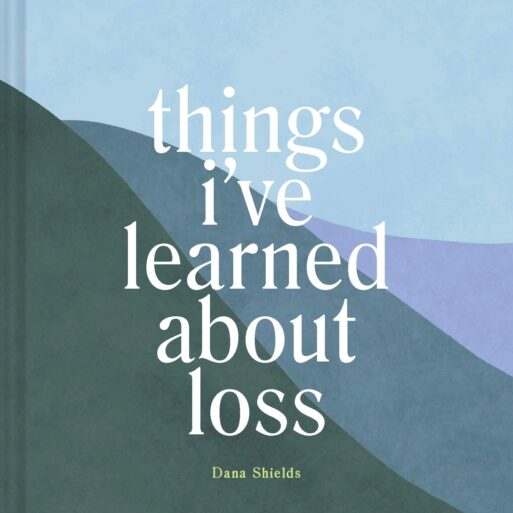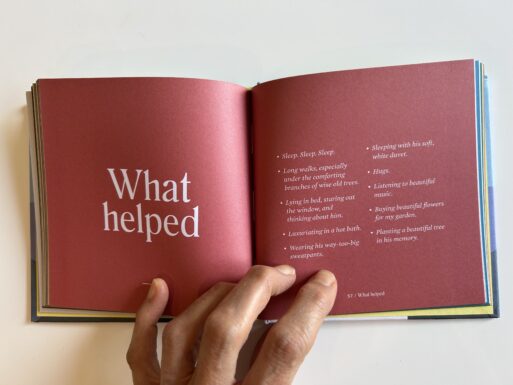
After the loss of her younger brother in a plane crash, Dana Shields faced a challenging grieving process. With time, support from family and friends and guidance from a therapist, Shields gradually healed and gained valuable insights into the nature of grief. When a close family friend experienced a similar loss during 9/11, Shields decided to share the lessons she had learned from her own experience by writing letters. Leveraging her background as a graphic designer, she transformed these lessons into a small, folding book that visualizes the range of emotions one experiences while grieving. She made copies of this book and distributed them to friends and family experiencing their own losses. As the demand for the book grew, Shields eventually edited and published it as, “Things I’ve Learned About Loss.”

Author Dana Shields painting.
The book begins by dispelling common myths about grief, emphasizing that everyone’s experience is unique and that grief does not always follow a predictable trajectory. Shields reassures readers that their grief is normal and that experiencing painful, uncomfortable emotions is a natural part of the grieving process. Throughout the book, pages change color to reflect the emotions and topics discussed. The content includes words of encouragement, personal anecdotes, and reminders that the reader’s experience is valid. The following passage captures the supportive and affirming tone of the book:
“Acceptance happens over time. It doesn’t mean you are no longer sad. It doesn’t mean your grieving is over. It just means you are healing, little by little. You are facing your pain and learning how to live with it” (39).
 In addition to addressing common emotions associated with grief, Shields covers other important, often overlooked aspects. She discusses first anniversaries, dealing with a loved one’s belongings, creating rituals to honor loved ones, and other coping strategies specific to loss. On the topic of a loved one’s belongings, Shields writes:
In addition to addressing common emotions associated with grief, Shields covers other important, often overlooked aspects. She discusses first anniversaries, dealing with a loved one’s belongings, creating rituals to honor loved ones, and other coping strategies specific to loss. On the topic of a loved one’s belongings, Shields writes:
“It can be incredibly difficult to part with a loved one’s belongings, but it is much easier if they stay within the family or with close friends you can visit” (43).
She then describes making “visits” to items belonging to her brother that have been given to family members or friends. These visits offer therapeutic social interactions while honoring the memory of the loved one. Although many grieving individuals are advised to move on and discard items, Shields emphasizes that there are meaningful ways to honor and preserve a loved one’s memory.
“Things I’ve Learned About Loss” is a compact, colorful, and accessible book that makes a thoughtful gift for anyone in the grieving process. The brief paragraphs, eye-catching design, and supportive tone can comfort readers as they enter this difficult time.
 However, some readers might find two aspects somewhat repetitive. First, the frequent reminders that one’s experience and feelings are normal, while reassuring, can become tedious reading. While it’s crucial for those grieving to know they are not “going crazy,” this sentiment is reiterated almost every other page. Second, the repeated emphasis on seeking therapy, though valuable, might feel excessive, especially to readers who are already in therapy or have a strong community network which they can rely on.
However, some readers might find two aspects somewhat repetitive. First, the frequent reminders that one’s experience and feelings are normal, while reassuring, can become tedious reading. While it’s crucial for those grieving to know they are not “going crazy,” this sentiment is reiterated almost every other page. Second, the repeated emphasis on seeking therapy, though valuable, might feel excessive, especially to readers who are already in therapy or have a strong community network which they can rely on.
Despite these minor drawbacks, the overall impression of the book is one of profound support. Shields makes readers feel seen and understood during what may be the most challenging time in their lives and for that, “Things I’ve Learned About Loss” makes a great gift.

 Things I’ve learned About Loss by Dana Shields
Things I’ve learned About Loss by Dana Shields


 Mishap With Grandpa’s Ashes Highlights Growing Trend to Keep Cremains at Home
Mishap With Grandpa’s Ashes Highlights Growing Trend to Keep Cremains at Home
















